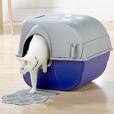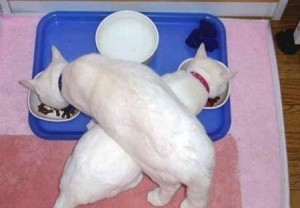Archive for November, 2009
Feeding a dog with diarrhea – your vet can recommend the proper pet medication for this problem.
 Lots of things can cause diarrhea in dogs and a single episode is probably nothing to worry about. You may not even need to see a veterinarian if it happens only one time. The first thing that you should do is make sure that your dog did not eat anything poisonous. Avoid treats and table scraps for a day or two. Limit his food intake to regular dog food. Make sure that you keep him well hydrated. Michael Leed, Professor of Small Animal Internal Medicine at Virginia Maryland Regional College of Veterinary Medicine says that usuually nothing specific has to be done. He says that most cases of diarrhea in dogs get better on their own without any specific treatment or pet medication. However if the diarrhea becomes more frequent or if blood and vomiting develop, your dog then needs to see a veterinarian.
Lots of things can cause diarrhea in dogs and a single episode is probably nothing to worry about. You may not even need to see a veterinarian if it happens only one time. The first thing that you should do is make sure that your dog did not eat anything poisonous. Avoid treats and table scraps for a day or two. Limit his food intake to regular dog food. Make sure that you keep him well hydrated. Michael Leed, Professor of Small Animal Internal Medicine at Virginia Maryland Regional College of Veterinary Medicine says that usuually nothing specific has to be done. He says that most cases of diarrhea in dogs get better on their own without any specific treatment or pet medication. However if the diarrhea becomes more frequent or if blood and vomiting develop, your dog then needs to see a veterinarian.
Self cleaning litter boxes, regular boxes do they matter to a cat?
 Litter boxes probably look more or less the same to us. We can purchase a self cleaning litter box, a regular box, a large box, smaller one etc. but the type of litter box does matter to a cat. Jackie Neilson, a Veterinary Behaviorist in Portland, Oregon says that cats do prefer litter boxes with certain amenities. Jackies’ research shows that many cats prefer clay based clumping litter to other kinds. Cats also like their litter box to smell nice. Carbon is the top choice for odor control. Most cats like their litter boxes roomy so they can dig and turn around comfortably. The bigger, the better but each cat has its preferences. You should find out the products that your cat likes best. If a cat likes its’ litter box it won’t find another one like a bed or a carpet to go on. So observe your cat and determine his likes and dislikes and you’ll never have to worry about any “accidents.”
Litter boxes probably look more or less the same to us. We can purchase a self cleaning litter box, a regular box, a large box, smaller one etc. but the type of litter box does matter to a cat. Jackie Neilson, a Veterinary Behaviorist in Portland, Oregon says that cats do prefer litter boxes with certain amenities. Jackies’ research shows that many cats prefer clay based clumping litter to other kinds. Cats also like their litter box to smell nice. Carbon is the top choice for odor control. Most cats like their litter boxes roomy so they can dig and turn around comfortably. The bigger, the better but each cat has its preferences. You should find out the products that your cat likes best. If a cat likes its’ litter box it won’t find another one like a bed or a carpet to go on. So observe your cat and determine his likes and dislikes and you’ll never have to worry about any “accidents.”
Rekindling the Puppy Spirit
 For the past 10 years my border terrier, aptly named Terry, has been one of my best friends. When he was a puppy, nothing seemed to faze him. He could go for a 10 mile run or stay outside in the winter weather for hours and never miss a beat.
For the past 10 years my border terrier, aptly named Terry, has been one of my best friends. When he was a puppy, nothing seemed to faze him. He could go for a 10 mile run or stay outside in the winter weather for hours and never miss a beat.
Now that he is getting on in years, Terry has lost much of his puppy-like exuberance. He rarely will go on jogs with me, and constantly shivers and shakes in the house. I recently picked him up a dog sweat shirt, and not only does Terry seem more comfortable, but it also gives him a younger, edgier appearance.
First she sharpens her nails on her cat scratching post then my cat “talks to the birds?”
 It’s a morning ritual. About 5:00am, my cat goes to her cat scratching post to sharper her nails then, like clockwork, comes in my bedroom, gets on the window sill and begins making a high pitched chattering sound. I call it “talking to the birds.” What is this sound? Even though your cat is a content little indoor kitty, he is a hunter by nature. Your cat is not calling the birds over to play with them but rather, he is watching his prey. Whether it be a bird or squirrel, he will make that high pitched chattering sound. The cat opens his mouth slightly, pulls his lips back, and then opens and closes his jaws very quickly. If he is really excited, he may add a high pitched vocal sound that sounds almost like a cry. The noise is instinctual. Behavioral specialists have noted the similarity of the noise to one made by cats delivering a special neck bite when killing a bird or small rodent. So your cat isn’t really “talking to to birds” but rather watching is prey even though the only prey he’ll ever get is the one on the end of his cat fishing pole!
It’s a morning ritual. About 5:00am, my cat goes to her cat scratching post to sharper her nails then, like clockwork, comes in my bedroom, gets on the window sill and begins making a high pitched chattering sound. I call it “talking to the birds.” What is this sound? Even though your cat is a content little indoor kitty, he is a hunter by nature. Your cat is not calling the birds over to play with them but rather, he is watching his prey. Whether it be a bird or squirrel, he will make that high pitched chattering sound. The cat opens his mouth slightly, pulls his lips back, and then opens and closes his jaws very quickly. If he is really excited, he may add a high pitched vocal sound that sounds almost like a cry. The noise is instinctual. Behavioral specialists have noted the similarity of the noise to one made by cats delivering a special neck bite when killing a bird or small rodent. So your cat isn’t really “talking to to birds” but rather watching is prey even though the only prey he’ll ever get is the one on the end of his cat fishing pole!
How many cats is too many? Lots and Lots of kitty litter, food, cat toys etc.
 You know that I am an animal lover. I saw a special on 20/20 the other evening. They did a story about people with too many cats. One woman had over 100 in her house!! I just want you to know that this is only my opinion. I always try to live a balanced life. I mean spending quality time for work, friends, family and my two cats. I also believe that when you adopt a pet, you should strive to give them a clean, healthy, happy and peaceful life. People who go to extremes and by “extremes” I mean having so many cats living indoors are not doing themselves or the animals any good. They create an imbalance in their lives. Caring for over many cats requires lots of time, money and cleaning. Think of all of the food, litter, cat toys, not to mention the expense incurred if they get sick.
You know that I am an animal lover. I saw a special on 20/20 the other evening. They did a story about people with too many cats. One woman had over 100 in her house!! I just want you to know that this is only my opinion. I always try to live a balanced life. I mean spending quality time for work, friends, family and my two cats. I also believe that when you adopt a pet, you should strive to give them a clean, healthy, happy and peaceful life. People who go to extremes and by “extremes” I mean having so many cats living indoors are not doing themselves or the animals any good. They create an imbalance in their lives. Caring for over many cats requires lots of time, money and cleaning. Think of all of the food, litter, cat toys, not to mention the expense incurred if they get sick.
You should also try to bond with your pets and having all of these cats limits the time you can spend with each of them. Now, please keep in mind, if you have cats that you keep outdoors and care for and feed them, then I guess it doesn’t matter how many but still there should be limits. If you are spending an enormous amount of time caring for your cats, then, you aren’t spending enough time on other things in your life. This creates an imbalance. Things could easily go awry if your life is not properly balanced with work, hobbies, play, pets and other loved ones. The lady with over 100 cats lived in filth. The cats looked unhealthy. They were on top of one another is an extremely unsanitary environment. They were certainly not living, happy, healthy lives. The person who owned these cats became so obsessed with caring for them that she neglected her own needs. The house was a filthy mess. I feel that everything in moderation is OK. My message here is that balance is important and this even applies to your pets. They need love and attention and going overboard and having so many is not doing the animals or yourself any good.
A guide to kitten vaccinations and diseases – Pet medication cannot help certain kitten diseases.
 As soon as you bring home your kitten, you must get him vaccinated. Your kitten should receive his first set of shots when he is between eight and ten weeks old. If your kitten has received some of their shots from another breeder, it is important that you get your veterinarians recommendation on how to proceed with his vaccinations.
As soon as you bring home your kitten, you must get him vaccinated. Your kitten should receive his first set of shots when he is between eight and ten weeks old. If your kitten has received some of their shots from another breeder, it is important that you get your veterinarians recommendation on how to proceed with his vaccinations.
Here is a guide to what the vaccinations are for.
Feline Leukemia – This is a viral disease that attacks the immune system and leaves it defenseless in fighting off infection. It is spread by saliva. Symptoms include recurring illness, weight loss, trouble breathing and a yellow color around the eyes and mouth.
Feline Pneumonitis (Chlamydia) – This is a bacterial disease that is highly contagious and causes upper respiratory infections. Symptoms includes watery eyes, sneezing and coughing.
Feline Calcivirus – This disease attacks the lungs are lower respiratory trac. This causes most of the respiratory infections in cats. It is highly contagious and is spread by sneezing. It is often complicated by other infections.
Feline Rhinotracheitis (FVR) This disease attacks the upper respiratory trac and is highly contagious to cats of all ages. Symptoms include sneezing, inflammation of the eye and fever.
Feline Panleukopenia (Feline Distemper – This in my opinion is the worst of all diseases. It attacks fast and fierce. Once your cat has symptoms, you do not have much time left to save him. It is the most widespread and contagious cat disease. It can be transmitted through blood, urine, feces and mucus. Symptoms include fever, diarrhea, vomiting and loss of appetite.
Get you kitten vaccinated right away and report any symptoms to your vet. Pet medication may be appropriate in some cases.
Rawhide bones is the only thing that your dog is chewing. Does he have a foot fetish?
 You may be a little puzzled when your dog suddenly is obsessed with his paws. He chews and licks them constantly. You look closely but cannot find any sores or splinters that can explain his behavior. Surprisingly, the answer to all of this licking and chewing may be allergies. Regardless if they’re caused by food, flees or environmental factors such as pollen, canine allergies can manifest themselves in your dogs skin which causes itching and discomfort. After your regular veterinarian exams your dog, a veterinary dermotologist can test for allergies. Treatment may involve changing foods, administering antihistimines, or giving you dog a medicated bath. So dog toys, rawhide bones and dad’s socks aren’t the only things that a dog can chew.
You may be a little puzzled when your dog suddenly is obsessed with his paws. He chews and licks them constantly. You look closely but cannot find any sores or splinters that can explain his behavior. Surprisingly, the answer to all of this licking and chewing may be allergies. Regardless if they’re caused by food, flees or environmental factors such as pollen, canine allergies can manifest themselves in your dogs skin which causes itching and discomfort. After your regular veterinarian exams your dog, a veterinary dermotologist can test for allergies. Treatment may involve changing foods, administering antihistimines, or giving you dog a medicated bath. So dog toys, rawhide bones and dad’s socks aren’t the only things that a dog can chew.
Five facts about caring for a Chihuahua – Do you need lots of dog coats?
 So you just took home your tiny Chihuahua, now you have to know how to care for it. Chihuahua’s are a wonderful breed and with a little know how, you both can enjoy a long and fun filled life together. Here are five facts to get you started.
So you just took home your tiny Chihuahua, now you have to know how to care for it. Chihuahua’s are a wonderful breed and with a little know how, you both can enjoy a long and fun filled life together. Here are five facts to get you started.
1. Feeding your Chihuahua – Your chihuahua must know that you’re the one that is in control. It is recommended that you feed him twice a day once in the morning and once around dinner time. I do not recommend table food unless you give him things like the white meat of a chicken or turkey once in a while. Check with your vet when it comes to table food. Feed your chihuahua about 8 to 10 hours apart. Also, give him a few treats two to three times a day and no more. I had a problem with my Chihuahua in that I gave him treats when he wanted them and then refused to eat his “real food.” Feed your Chihuahua wisely. A poor diet can led to poor health.
2. Bathing your Chihuahua – You may bath him about once a month. Chihuahuas’ are groom themselves well and rarely have that “dog smell.” Use a mild shampoo with a moisturizer to prevent dry skin. Make sure that you dry him thoroughly. A wet chihuahua is a cold chihuahua. Do not bath puppies that have not had all of their vaccinations. Consult your veterinarian as to when to start bathing him.
3. Brushing your Chihuahua – You really don’t have to brush him often because his hair is short and he won’t shed that much.
4. Nail Clipping – This is a nerve racking experience. Leave this to the experts and have your vet do it.
5. Walking your Chihuahua – Make sure that you walk your chihuahua at least three to four times a day. Puppies need to be walked more often. Make the walks fairly long to give him the exercise that he needs. Being that chihuahua’s are small dogs, they get cold very easily. Have a few dog coats on hand and use them when it gets cold.
Good luck and enjoy your little friend!
The cat food compromise – is a new cat scratching post in order?
 You seem that you always have to “bargain” with your cat when it comes to his food. People are always fighting as to whether it’s best to feed him wet or dry food. Some people say that wet food better mimics a cats natural diet. Because it contains more protein and water, it helps prevent dehydration and urine chrystals. Dry food doesn’t spoil as easily and may be a better way to prevent tarter and protect your cats’ teeth. So what do you do? Many veterinarians believe that the best thing to do is actually a compromise. No – it isn’t buying him a new cat toy or new cat scratching post. Feeding your cat both wet and dry food allows you to give your cat the best of both worlds. So now you could put the debate to rest and focus on providing plenty of water and food that best suits your cats lifestyle. Ask your veterinarian for a recommendation. I feed my cats a small can of wet food (which I split in half for two cats), then a bowl of dry food followed by a snack in the evening. It seems to work out just fine. If your cat is an indoor cat, I would suggest that you feed food that indicates “for indoor cats” on the package. You don’t want your cat to get too heavy!
You seem that you always have to “bargain” with your cat when it comes to his food. People are always fighting as to whether it’s best to feed him wet or dry food. Some people say that wet food better mimics a cats natural diet. Because it contains more protein and water, it helps prevent dehydration and urine chrystals. Dry food doesn’t spoil as easily and may be a better way to prevent tarter and protect your cats’ teeth. So what do you do? Many veterinarians believe that the best thing to do is actually a compromise. No – it isn’t buying him a new cat toy or new cat scratching post. Feeding your cat both wet and dry food allows you to give your cat the best of both worlds. So now you could put the debate to rest and focus on providing plenty of water and food that best suits your cats lifestyle. Ask your veterinarian for a recommendation. I feed my cats a small can of wet food (which I split in half for two cats), then a bowl of dry food followed by a snack in the evening. It seems to work out just fine. If your cat is an indoor cat, I would suggest that you feed food that indicates “for indoor cats” on the package. You don’t want your cat to get too heavy!
A serious internal condition – Pet medication can not solve it alone.
 Pleural Effusion is a condition where fluid or pus accumulates in an animals chest cavity compressing the lungs and heart. Leah Cohn, Professor of Veterinary Internal Medicine at the University of Missouri says that animals with pleural effusion have to breathe very rapidly because they can’t expand their lungs. They take short, shallow, rapid breaths. She says the pleural effusion has many potential causes such as infection and congestive heart failure. Treatment will vary. If a pet is struggling to breath, most veterinarians will remove the fluid with a needle and syringe. This is a process that may need to be repeated until the underlying cause of the fluid buildup can be cured. In this case pet medication alone will not cure this kind of problem. If you notice your pet breathing very rapidly, take him to your vet right away.
Pleural Effusion is a condition where fluid or pus accumulates in an animals chest cavity compressing the lungs and heart. Leah Cohn, Professor of Veterinary Internal Medicine at the University of Missouri says that animals with pleural effusion have to breathe very rapidly because they can’t expand their lungs. They take short, shallow, rapid breaths. She says the pleural effusion has many potential causes such as infection and congestive heart failure. Treatment will vary. If a pet is struggling to breath, most veterinarians will remove the fluid with a needle and syringe. This is a process that may need to be repeated until the underlying cause of the fluid buildup can be cured. In this case pet medication alone will not cure this kind of problem. If you notice your pet breathing very rapidly, take him to your vet right away.